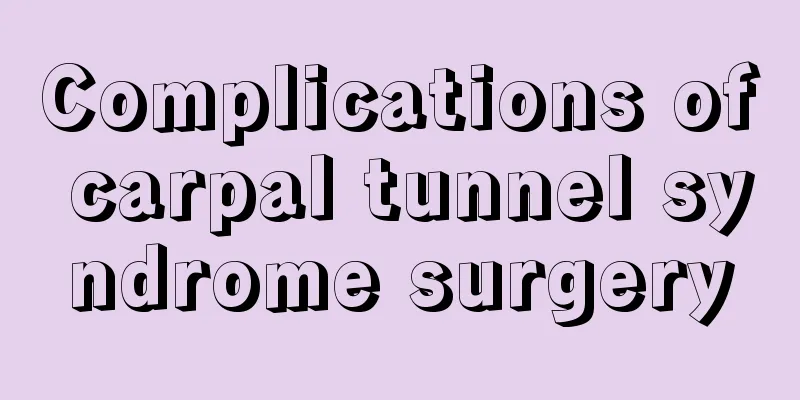Complications of carpal tunnel syndrome surgery

|
Carpal tunnel syndrome is a common surgical disease and often requires surgical treatment. Since we do not have medical expertise, we do not understand this disease. The main symptoms of this disease are abnormal sensations in the fingers, difficulty in flexion and extension, and severe cases of no sensation in the fingers. The cause of this disease is compression of the nerves in the wrist. Surgical treatment of carpal tunnel syndrome generally does not leave sequelae. Let us understand how this disease is treated. 1. Non-surgical treatment There are many non-surgical treatments for carpal tunnel syndrome, including brace immobilization and corticosteroid injections. Doctors often recommend that patients use braces to control the progression of the disease and relieve symptoms. Commonly used are prefabricated braces, which control the wrist joint in a 30-degree dorsiflexion position after wearing. However, this dorsiflexion angle will increase the pressure in the carpal tunnel. Studies have shown that patients with carpal tunnel syndrome have increased pressure in the carpal tunnel, and the pressure increases further when the wrist joint is extended. The most effective position for controlling symptoms is neutral. Fixing the wrist joint in a neutral position can reduce the pressure in the carpal tunnel, but the wrist joint position that is most conducive to the function of the hand is 30 degrees of dorsiflexion. Considering that the neutral position is not conducive to the performance of manual functions, the general recommendation is not to fix the wrist in the neutral position during the day and to use a brace to fix the wrist joint in the neutral position at night. Oral anti-inflammatory drugs and local injection of corticosteroids are also commonly used methods, with varying success rates reported in the literature. Celiker et al. compared the efficacy of corticosteroid injection and nonsteroidal anti-inflammatory drugs combined with brace immobilization through a randomized controlled study. The results showed that the symptoms of both groups of patients were significantly improved. However, since the follow-up was only 8 weeks, the conclusion is not convincing enough. Edgell et al. and Green both believe that if local injection can temporarily relieve symptoms, the success rate of surgery is high. There are also literature reports that hormone injections have complications, such as damage to the median nerve. Studies in rodent experimental models have shown that even if dexamethasone is injected directly into the nerves, it will not damage the nerves. All other steroid drugs damaged the nerve when injected into the rats' sciatic nerve. Therefore, although corticosteroid injections may provide temporary relief of symptoms, they are not recommended for routine use. . 2. Surgical treatment If conservative treatment cannot relieve the patient's symptoms, surgical treatment should be considered. In 1924, Herbert Galloway performed the first carpal tunnel release surgery. After that, a variety of surgical methods emerged, including various incision surgeries, small incision decompression and endoscopic surgery. Although the goal of surgery is to release the median nerve, it is possible that one or even several median nerves may be injured due to iatrogenic causes. Therefore, no matter which surgical method is preferred, it should be based on the premise that the median nerve can be fully exposed to avoid nerve injury. For patients with damaged wrist structures, space-occupying lesions, synovial lesions, and those who need secondary release and decompression, it is best to perform open release and decompression, and the incision should be long so that additional surgery can be performed. When problems arise when using a short incision, such as difficulty in operation or difficulty in seeing directly, the incision should be extended, changing the short incision into a long incision to avoid accidents. Endoscopic technology is a "minimally invasive" surgical treatment method with small incisions and less trauma, which can avoid problems such as postoperative incision discomfort. Currently, there are many literatures on the use of various endoscopic techniques; however, there are also certain problems, such as iatrogenic nerve injury, poor visual field, inability to distinguish anatomical variations, inadequate release, and high costs. If the field of view is insufficient, open surgery should be performed instead. Some doctors also believe that small incision decompression surgery is also a "minimally invasive technique" and can reduce the rate of postoperative complications. Endoscopic "minimally invasive" carpal tunnel release surgery is divided into two categories: double entry (Chow method) and single entry (Agee method). The double approach is to make a small incision of about 25cm on the proximal and distal sides of the carpal tunnel, and under the guidance of an endoscope, use a small hook knife to cut the flexor retinaculum. The single approach only requires a small incision to be made proximal to the carpal tunnel, and under the guidance of an endoscope, a special incision is used to cut and release the flexor retinaculum. |
<<: How many cordyceps should be put in one pound of wine?
>>: How to treat weak pulse and get better quickly
Recommend
What are the symptoms of early nasopharyngeal carcinoma?
What are the symptoms of early nasopharyngeal can...
Are there any side effects of abdominal breathing during exercise?
In normal times, many people love to do sports, b...
How can lung cancer patients adjust their diet? Dietary considerations for lung cancer patients
The lungs are in the human body, and many patient...
What are the functions of the parasympathetic nervous center
The role of the parasympathetic nervous center is...
Does rib fracture hurt? Here’s what you need to know
Fractures are obviously painful for many people, ...
What is the treatment for wind-heat cold headache?
The cold is a wind-heat cold, which can cause hea...
What are the symptoms of uterine cancer? Should uterine cancer be treated surgically?
Uterine cancer is a malignant tumor that occurs i...
Tips to quit sweets
There are some additives in sweets that can make ...
How to prevent and treat cerebral infarction more effectively?
We must pay more attention to the prevention of c...
What are the benefits of taking a bath in summer
The weather in summer is very hot. If you do not ...
How many calories does running for 20 minutes burn?
Running for 20 minutes can promote gastrointestin...
Which part of the cow is roasted butter?
Everyone knows that butter is condensed milk extr...
How to remove the skin of walnut kernels
Maybe many of us like to eat walnuts. Walnut kern...
The main forms of radiotherapy for gastric cancer
Radiotherapy is one of the commonly used methods ...
Do I need to fast for blood test?
I believe everyone is familiar with routine blood...









